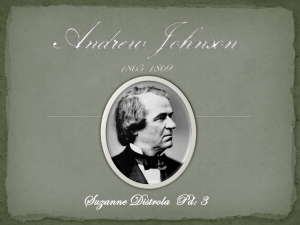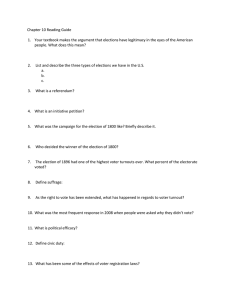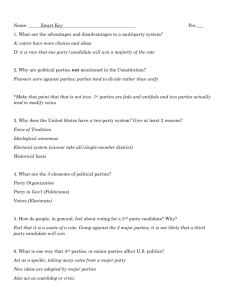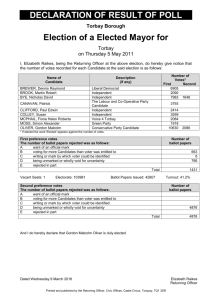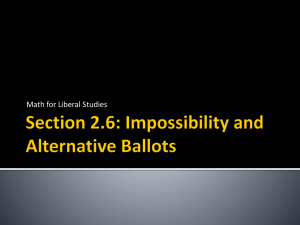Document 10505602
advertisement
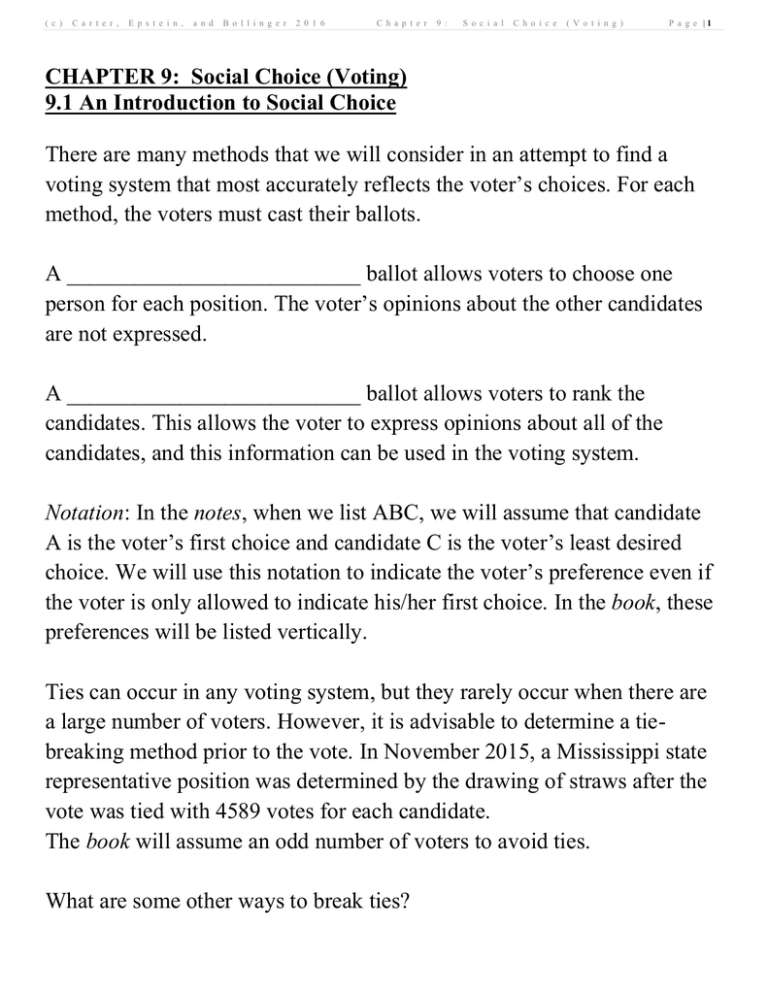
( c ) C a r t e r , E p s t e i n , a n d B o l l i n g e r 2 0 1 6 C h a p t e r 9 : S o c i a l C h o i c e ( V o t i n g ) P a g e |1 CHAPTER 9: Social Choice (Voting) 9.1 An Introduction to Social Choice There are many methods that we will consider in an attempt to find a voting system that most accurately reflects the voter’s choices. For each method, the voters must cast their ballots. A __________________________ ballot allows voters to choose one person for each position. The voter’s opinions about the other candidates are not expressed. A __________________________ ballot allows voters to rank the candidates. This allows the voter to express opinions about all of the candidates, and this information can be used in the voting system. Notation: In the notes, when we list ABC, we will assume that candidate A is the voter’s first choice and candidate C is the voter’s least desired choice. We will use this notation to indicate the voter’s preference even if the voter is only allowed to indicate his/her first choice. In the book, these preferences will be listed vertically. Ties can occur in any voting system, but they rarely occur when there are a large number of voters. However, it is advisable to determine a tiebreaking method prior to the vote. In November 2015, a Mississippi state representative position was determined by the drawing of straws after the vote was tied with 4589 votes for each candidate. The book will assume an odd number of voters to avoid ties. What are some other ways to break ties? ( c ) C a r t e r , E p s t e i n , a n d B o l l i n g e r 2 0 1 6 C h a p t e r 9 : S o c i a l C h o i c e ( V o t i n g ) P a g e |2 9.2 Majority Rule and Condorcet’s Method When creating a voting system, we have three goals for fairness: All ____________ are treated equally. If voters switched marked ballots, it would not change the outcome of the election. In other words, it does not matter who casts each ballot because everyone’s votes are weighted equally. All ____________ are treated equally. If every voter reversed his/her vote, the outcome of the election would also be reversed. Election results are ______________________. Assume that candidate A won the election, but the votes were recounted. The only errors discovered were that some votes originally counted for other candidates should have been counted for candidate A. Then candidate A should still win the election. Majority Rule Each voter votes for one candidate. The candidate with the majority of the votes wins. Majority means more than ____________. For two candidates, majority rule meets all three goals for fairness. The notes and book let the reader know the entire preference list of the voters. Assume that the voter votes for his/her first preference. Condorcet’s Method Each voter ranks the candidates (preference list voting). Each candidate is compared to every other candidate. If one candidate wins all of his/her one-on-one contests, he/she is declared the Condorcet winner. ( c ) C a r t e r , E p s t e i n , a n d B o l l i n g e r 2 0 1 6 C h a p t e r 9 : S o c i a l C h o i c e ( V o t i n g ) P a g e |3 Example Assume that the following list reflects the voting preferences of all voters. Pref. List YXZ 2 YZX 1 ZYX 4 ZXY 0 (b) Who is the Condorcet winner? Pref. List XYZ XZY YXZ # Voters 5 0 2 YZX 1 ZYX 4 ZXY 0 # Voters XYZ 5 XZY 0 (a) Who is the majority winner? Candidate Votes X Y Z Choices Votes Choices X over Y Y over X X over Z Z over X Y over Z Z over Y Votes Winner ( c ) C a r t e r , E p s t e i n , a n d B o l l i n g e r 2 0 1 6 C h a p t e r 9 : S o c i a l C h o i c e ( V o t i n g ) P a g e |4 Example Assume that the following list reflects the voting preferences of all voters. Who is the Condorcet winner? Pref. List # Voters ABC 4 Choices Votes BCA 4 CAB 4 Choices A over B B over A A over C C over A B over C C over B Votes Winner This is an example of Condorcet’s ______________________ because the voters’ preferences are cyclic (the group of voters prefer A over B, B over C, and C over A). Condorcet’s paradox is exhibited in the game Rock, Paper, Scissors. 9.3 Other Voting Systems for Three or More Candidates Plurality Voting Each voter votes for one candidate. The candidate with the ___________ votes wins. A candidate can win a plurality vote with less than half the votes. The notes and book let the reader know the entire preference list of the voters. Assume that the voter votes for his/her first preference. In the 2000 presidential election, George Bush won the plurality of the votes, but polling data indicates that Al Gore would have won using the Condorcet method. ( c ) C a r t e r , E p s t e i n , a n d B o l l i n g e r 2 0 1 6 C h a p t e r 9 : S o c i a l C h o i c e ( V o t i n g ) P a g e |5 Example Assume that the following list reflects the voting preferences of all voters. Pref. List # Voters XYZ 5 XZY 0 YXZ 2 YZX 1 ZYX 4 ZXY 0 Who is the plurality winner? Candidate Votes X Y Z A voting system is ___________________ if there are elections in which it is to a voter’s advantage to submit a ballot that misrepresents his or her true preferences. Plurality voting is manipulable. This is often exhibited in our presidential elections by voters who support a third-party candidate but vote for a candidate from one of the two major parties. One of the strengths of Condorcet’s method is that it is not manipulable. ( c ) C a r t e r , E p s t e i n , a n d B o l l i n g e r 2 0 1 6 C h a p t e r 9 : S o c i a l C h o i c e ( V o t i n g ) P a g e |6 Borda Count and other Rank Methods A ____________ method of voting assigns points in a nonincreasing manner to the ordered candidates on each voter’s preference list ballot then sums these points to arrive at a group’s final ranking (more points indicate a higher ranking). A rank method in which there are n candidates with first place votes receiving 𝑛 − 1 points, second place receiving 𝑛 − 2 points, and so on down to each last-place vote receiving 0 points is called the ___________ count. Example Find the Borda count to rank candidates X, Y, and Z. Pref. List XYZ XZY YXZ YZX # Voters 5 0 2 1 1st place * ___ pts X Y Z Ranking: ZYX 4 2nd place * ___ pt 3rd place * ___ pts ZXY 0 Total ( c ) C a r t e r , E p s t e i n , a n d B o l l i n g e r 2 0 1 6 C h a p t e r 9 : S o c i a l C h o i c e ( V o t i n g ) P a g e |7 Example A sports award uses a rank method with 5 points for first place, 3 points for second place, 2 points for third place, 1 point for 4th place, and 0 points for any place below 4th place. Rank the candidates (A, B, C, D, E, F, G) for this award. Pref. List ABCDEF CDFAEB ADCBEG BACDFG ACBDFE # Voters 4 3 2 1 5 1st place * 5 pts 2nd place * 3 pts 3rd place * 2 pts 4th place * 1 pt A B C D E F G Ranking: Rank methods are often used for sports award rankings. Total ( c ) C a r t e r , E p s t e i n , a n d B o l l i n g e r 2 0 1 6 C h a p t e r 9 : S o c i a l C h o i c e ( V o t i n g ) P a g e |8 Runoff Election If there is no majority winner, _________________ is taken after eliminating one or more of the candidates. The top two candidates could be in the runoff, or the Hare System (described below) could be used. Hare System If there is no majority winner, then the candidate with the fewest number of __________________________ votes is eliminated and the results are calculated again. If there is still no majority winner, the process continues until a majority winner is found or the remaining candidates are tied. Example Use the Hare system to determine a winner. Pref. List XYZ XZY YXZ YZX # Voters 3 2 1 5 Candidate Votes in 1st round X Y Z Winner using the Hare system: _____________ ZYX 4 Votes in 2nd round ZXY 2 ( c ) C a r t e r , E p s t e i n , a n d B o l l i n g e r 2 0 1 6 C h a p t e r 9 : S o c i a l C h o i c e ( V o t i n g ) P a g e |9 Sequential Pairwise Voting In sequential pairwise voting candidates are compared two at a time in a ________________________ order known as an agenda. The winner of the pairing is compared to the next candidate on the pre-determined list. This process continues until a winner is determined. Unfortunately, the order of the pairings can affect who wins the election. However, this process is used by our legislature as bills are presented. As amendments to the bill are proposed, the votes are either for the current version of the bill or the amended version. After that process has concluded, a final vote (yes/no) is taken on the amended version (rather than allowing a choice of no bill, original version, or amended version). Example Assume that the following list reflects the voting preferences of all voters. Pref. List ABDC CABD BDCA # Voters 1 1 1 (a) Who is the Condorcet winner? Choices Votes Choices A over B B over A A over C C over A A over D D over A B over C C over B B over D D over B C over D D over C Votes Winner ( c ) C a r t e r , E p s t e i n , Choices A over B A over C A over D B over C B over D C over D a n d B o l l i n g e r Votes 2 1 2 2 3 1 2 0 1 6 C h a p t e r Choices B over A C over A D over A C over B D over B D over C 9 : S o c i a l C h o i c e Votes 1 2 1 1 0 2 ( V o t i n g ) P a g e | 10 Winner A C A B B D (b) Who is the sequential pairwise winner if the agenda is ABCD? (c) Who is the sequential pairwise winner if the agenda is BCDA? (d) Who is the sequential pairwise winner if the agenda is ACDB? (e) Who is the sequential pairwise winner if the agenda is DBAC? ( c ) C a r t e r , E p s t e i n , a n d B o l l i n g e r 2 0 1 6 C h a p t e r 9 : S o c i a l C h o i c e ( V o t i n g ) P a g e | 11 9.5 Approval Voting Each voter votes for all the candidates they find acceptable (approve of). The candidate with the ______________________________ wins. Example A family is deciding what to serve for dinner on Saturday and Sunday. Mom draws up a list and the votes are listed below. What will the family have for dinner this weekend? Mom Dad Boy Girl 1 Girl 2 Total Liver and Onions Y Lamb Stew Y Y Fish Sticks Y Y Y Fried Chicken Y Y Hamburgers Y Y Y Y Y Spaghetti Y Y Y Y Example A group is deciding what movie to see. The votes are listed below. What movie will they go see? Number of Ballots Spectre Star Wars Bridged Joy Sisters Hunger Games 8 5 3 Y Y Y Y Y Y Y Y Y 3 1 Total Y Y Y Y Y Y Y Y ( c ) C a r t e r , E p s t e i n , a n d B o l l i n g e r 2 0 1 6 C h a p t e r 9 : S o c i a l C h o i c e ( V o t i n g ) P a g e | 12 Fairness Criteria (9.3 and 9.4) Majority Criterion If a candidate receives a majority of the first place votes, then that candidate should be declared the winner. Example Assume that the following list reflects the voting preferences of all voters. Pref. List XYZ YZX ZYX # Voters 16 8 7 (a) Who is the majority winner? Candidate Votes X Y Z (b) Use the Borda count to determine the winner. 1st place * 2 pts 2nd place * 1 pts 3rd place * 0 pt Total X Y Z (c) Did the Borda count uphold the majority fairness criterion in this example? ( c ) C a r t e r , E p s t e i n , a n d B o l l i n g e r 2 0 1 6 C h a p t e r 9 : S o c i a l C h o i c e ( V o t i n g ) P a g e | 13 Condorcet Criterion If a candidate is favored when compared one-on-one with every other candidate, then that candidate should be declared the winner. Example Assume that the following list reflects the voting preferences of all voters. (a) Who is the Condorcet winner? Pref. List # Voters Choices A over B DABC 120 ACBD 100 Votes BCAD 90 Choices B over A A over C C over A A over D D over A B over C C over B B over D D over B C over D D over C CBDA 80 Votes CBAD 45 Winner ( c ) C a r t e r , E p s t e i n , a n d B o l l i n g e r 2 0 1 6 C h a p t e r (b) Who is the plurality winner? Pref. List DABC ACBD BCAD # Voters 120 100 90 9 : S o c i a l C h o i c e ( V o t i n g ) CBDA 80 CBAD 45 (d) Who is the winner using the Hare method? Pref. List DABC ACBD BCAD CBDA # Voters 120 100 90 80 CBAD 45 Candidate P a g e | 14 Votes A B C D (c) Who is the majority winner? Candidate Votes in 1st round A B C D Votes in 2nd round Votes in 3rd round ( c ) C a r t e r , E p s t e i n , a n d B o l l i n g e r 2 0 1 6 C h a p t e r 9 : S o c i a l (e) Who is the winner using the Borda count? Pref. List DABC ACBD BCAD CBDA # Voters 120 100 90 80 1st place * 3 pts 2nd place * 2 pts C h o i c e ( V o t i n g ) P a g e | 15 CBAD 45 3rd place * 1 pt Total A B C D (f) Which of the methods failed to meet the Condorcet criterion for this example? Monotonicity Criterion This was initially described in section 9.1. Assume that candidate A won the election, but the votes were recounted. The only errors discovered were that some votes originally counted for other candidates should have been counted for candidate A. Then candidate A should still win the election. A candidate who wins a first election and then gains additional support, without losing any of the original support, should also win a second election. ( c ) C a r t e r , E p s t e i n , a n d B o l l i n g e r 2 0 1 6 C h a p t e r 9 : S o c i a l C h o i c e ( V o t i n g ) P a g e | 16 Example The IOC was voting for the Winter Olympics to be held in Quebec (Q), Salt Lake City (L), Ostersund (T) or Sion (S). They took a straw vote (a preliminary vote that is not binding) on the first day. They took a binding vote on the second day. A total of 87 votes were cast (fictional data). Day 1 Pref. List TLSQ LQTS QSTL TQSL TSLQ # Voters 21 24 30 6 6 (a) Use the Hare Method to determine the winner from Day 1. Candidate Votes in 1st round Votes in 2nd round Votes in 3rd round Q L T S ( c ) C a r t e r , E p s t e i n , a n d B o l l i n g e r 2 0 1 6 C h a p t e r 9 : S o c i a l C h o i c e ( V o t i n g ) P a g e | 17 (b) That night, the 12 people who preferred TQSL and TSLQ decided to move Q to the top of their list without changing any other preferences. Use the Hare Method to determine the winner from Day 2. Day 2 Pref. List TLSQ LQTS QSTL QTSL QTSL # Voters 21 24 30 6 6 Candidate Votes in 1st round Votes in 2nd round Votes in 3rd round Q L T S (c) In this example, did the Hare Method violate the monotonicity criterion? ( c ) C a r t e r , E p s t e i n , a n d B o l l i n g e r 2 0 1 6 C h a p t e r 9 : S o c i a l C h o i c e ( V o t i n g ) P a g e | 18 Independence of Irrelevant Alternatives If a candidate would be declared the winner of an election and one or more of the non-winning candidates is removed, then the previous winner should still be declared the winner. In other words, in order for a candidate to go from losing an election to winning an election, at least one voter should have to reverse his or her ranking of that candidate and the previous winner. Example There are 3 candidates and 20 voters with preferences listed below. Pref. List XYZ ZYX YXZ # Voters 7 8 5 (a) Who would be the winner using Hare’s method? Candidate Votes in 1st round Votes in 2nd round X Y Z (b) If candidate Z dropped out before the election and no voters changed their preference, who would win the election? Pref. List XYZ ZYX YXZ # Voters 7 8 5 Candidate X Y Votes ( c ) C a r t e r , E p s t e i n , a n d B o l l i n g e r 2 0 1 6 C h a p t e r 9 : S o c i a l C h o i c e ( V o t i n g ) P a g e | 19 No Perfect System We have seen problems with all of the methods that we discussed. Kenneth Arrow proved that with three or more candidates, there does not (and cannot ever) exist a voting system that always produces a winner, satisfies the Pareto condition (if every voter prefers candidate X over candidate Y, then candidate Y will not be a winner), and satisfies the Irrelevant Alternatives condition that is not a dictatorship.
